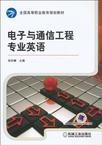电子与通信工程专业英语
出版时间:2010-8 出版社:机械工业出版社 作者:徐存善 编 页数:279
前言
随着科技进步和社会的发展,我国对专业人才英语能力的要求越来越高。电子与通信工程是当今世界发展最迅速、技术更新最活跃的领域之一。我国在该领域注重引进世界先进技术和设备,同时要发展和创造外向型经济,因此该领域对具有专业英语能力人才的需求比以往任何时候都更加迫切。为了更好地培养学生的专业外语能力,促进具有国际竞争力的人才培养,我们在追求通俗易懂、简明扼要、便于教学和自学的指导思想下编写了这本《电子与通信工程专业英语》。 全书由四部分组成,即电子技术基础、通信技术、计算机技术和电子与通信工程。内容多取材于原版的专业资料或专业英语教科书,基本涵盖了电子技术基础、仪器仪表使用与维护、计算机技术应用、网络与多媒体技术、通信技术等领域,同时还收录了一些电子信息技术发展前沿的文章,如遥感技术、数字信号处理、电路仿真、数字电视、3G技术、GPS等。课文内容丰富、题材广泛,语言通俗地道,能满足大多数学生对专业英语的学习需求。 本书共26个单元,每单元包括课文、生词、专业术语、课文注释、翻译技巧和阅读材料。在最后6个单元中,用相当篇幅分别介绍了英语网站注册申请、中外著名电子信息公司、英语招聘广告的阅读、个人简历和求职信的书写、面试技巧等,目的是使毕业生在外资或合资企业的就业竞争中能胜人一筹。附录部分汇编了8个单元职业现场的交际对话、各单元的参考译文与部分习题答案(为了培养学生的独立阅读能力,部分阅读材料的参考译文和习题答案只在电子教案中给出)、生词表、常用专业术语缩略语等内容。 本书可作为高职高专应用电子技术、计算机控制与应用、网络与多媒体技术以及通信技术等专业的英语教材。每单元参考学时为2~3学时。建议教师根据学生的接受能力和本校学时情况选用本书15~20个单元的内容,同时配合生动活泼、灵活多样的互动式教学与课后练习讨论,多方位培养学生的专业英语兴趣与应用能力。对于教师在授课中没有选入的单元,学生可根据自己的学习兴趣自学,以拓宽专业英语的知识面。 本书由河南工业职业技术学院徐存善副教授主编。编写分工为:徐存善编写第1~4单元和附录C;王美娥编写第5~8单元;薛红勤编写第9单元和附录A;王存才编写第lO单元;乔竞宇编写第ll单元;赵莹编写第12单元;郭静编写第13单元:高玲编写第14~16单元;杨文铂编写第17单元和附录D;席东河编写第18、19两个单元;赵转莉编写第20~22单元;谭胡心编写第23单元;唐红莲编写第24~26单元;附录B中各单元参考译文和习题答案分别由相应作者提供。 本书的编审工作得到了编者所在院校领导的高度重视与大力支持。齐智英教授、刘明黎主任为本教材的编写提出了宝贵意见,在此一并表示衷心的感谢。 由于时问仓促,加上编者水平有限,书中难免有不足之处,恳请广大读者批评指正。
内容概要
本书由电子技术基础、通信技术、计算机技术和电子与通信工程四部分组成,共有26个单元。每单元包括课文、生词与短语、注释、练习、翻译技巧和阅读材料,内容多取材于原版的专业资料或专业英语教科书,语言真实地道,内容生动新颖,联系职业实际,应用性强,有助于从不同侧面有针对性地培养学生的专业英语实用技能,提高学生阅读和翻译英文技术文献与专业资料的能力,以及在一定场景下用英语进行交流的能力。书后附有部分习题答案和参考译文,便于帮助学生理解和检查自己所掌握的内容,在一定程度上减轻了学习的难度。 本书适合高职高专(含成人教育学院)电子技术、电子通信类专业和计算机控制等专业的学生使用,也可供相关专业的工程技术人员参考学习,或作为中等职业学校相关专业的学生用书。
书籍目录
出版说明前言ChapterⅠ Fundamentals of Electronics Technology Unit 1 Current, Voltage and Resistance Translating Skills:科技英语翻译的标准与方法 Reading:Conductors,Insulators and Semiconductors Unit 2 Resistor, Capacitor and Inductor Translating Skills:词义的确定 Reading:How to Use a Tester Unit 3 The Transistor and Its Basic Circuit Translating Skills:引申译法 Reading:Transistor Voltage Amplifier Unit 4 Multimeters and Oscilloscopes Translating Skills:词性转换 Reading:Oscillator Unit 5 Operational Amplifier Translating Skills:增词译法 Reading:Registers Unit 6 Linear Circuit Analysis Translating Skills:减词译法 Reading:Thevenin's Theorem Unit 7 Integrated Circuit Translating Skills:科技英语词汇的结构特征(Ⅰ) Reading:Digital Circuit ChapterⅡ Communication Technology Unit 8 Basic Knowledge of Communication Translating Skills:科技英语词汇的结构特征 (Ⅱ) Reading:Wireless Communications Unit 9 Mobile Communications Translating Skills:介词的译法 Reading:World Wide Web Unit 10 Internet Telephony and VoIP Translating Skills:被动语态的译法 Reading:Cell Phones and the Cell Approach Unit 11 Introduction to 3G Translating Skills:非谓语动词V-ing 的用法 Reading:Videoconferencing Unit 12 Optical Fiber Communications Translating Skills:非谓语动词V-ed和to V的用法 Reading:Faster-Than-Light Electric Pulses Unit 13 Satellite Communication Systems Translating Skill:科技英语一些常用结构的表达 Reading:E-mail & Instant Messaging Chapter Ⅲ Computer Technology Unit 14 Computer Systems Translating Skills:反译法 Reading:Computer Graphics Unit 15 The Applications of Computers Translating Skills:定语从句的翻译 Reading:Data Management Unit 16 Computer Networks Translating Skills:and 引导的句型的译法 Reading:Network Protocols Unit 17 Multimedia Technology Translating Skills:数量增减的翻译 Reading:MIDI Interface Unit 18 Introduction to Artificial Intelligence Translating Skills:虚拟语气的翻译 Reading:Computer Vision Unit 19 Single-Chip Microprocessors Translating Skills:长难句的翻译 Reading:Chip and Chip Holders Chapter Ⅳ Electronic and Communicative Engineering Unit 20 Digital Signal Processing (DSP) Practical English:电子产品的英文说明书 Reading:Phase Lock Techniques Unit 21 Digital Television and Liquid Crystal Display Useful Information:专业网站介绍与英文网站注册申请表的填写 Reading:Pure Vision Plasma Display Unit 22 Computer Simulation Useful Information:中外著名电子信息公司简介 Reading:Circuit Switching and Packet Switching Unit 23 Introduction to Internet Practical English:怎样阅读英文招聘广告 Reading:GPS Unit 24 Automatic Control System Practical English:怎样用英文写个人简历 Reading:Automating the Analysis of Faults and Power Quality Unit 25 Sensor Technology Practical English:怎样写英文求职信 Reading:Remote Sensing Unit 26 User's Manual Practical English:面试技巧 Reading:Introductions to NE555 and AD574A Appendix Appendix A Communication Skills Training for Careers Appendix B Translation and Key to the Exercises Appendix C New Words List Appendix D Widely Used Abbreviations for Technical Terms 参考文献
章节摘录
Insulators generally have very stable atomic structures, of which the 4-electron outer-ring structureis typical. In such a structure, there is an absence of easily removed electrons. Examples of goodinsulators are certain compounds of carbon and diamond, which has a similar atomic structure. Semiconductors are a group of materials, which conduct electrons poorly and therefore cannotproperly be classified either as conductors or insulators. Generally, semiconductors differ frominsulators in that their outer-ring electrons can detach themselves from their orbits more easily thanin insulators. Typical semiconductors materials are germanium and silicon. Impurities may be added to pure semiconductors. This results in semiconductor materials,which may either have an excess of free electrons or a deficiency of orbital electrons. When anexcess of electrons is present we call the material N-type; when lack of orbital electrons occurs,we call the material P-type. Both N-type and P-type semiconductors are made by treatedmaterials. The addition of impurities to semiconductors is called doping.
图书封面
评论、评分、阅读与下载
用户评论 (总计1条)
- 昨天收到后还没来得及看,浏览了一哈感觉还行!
